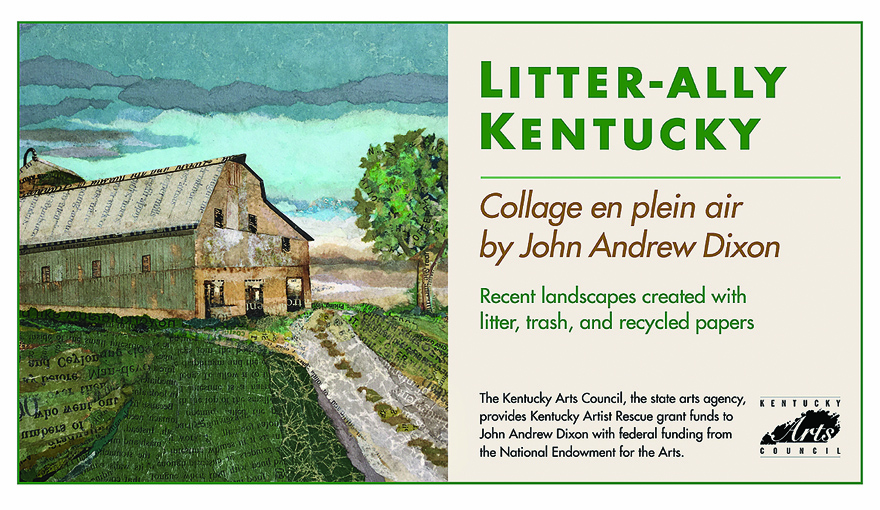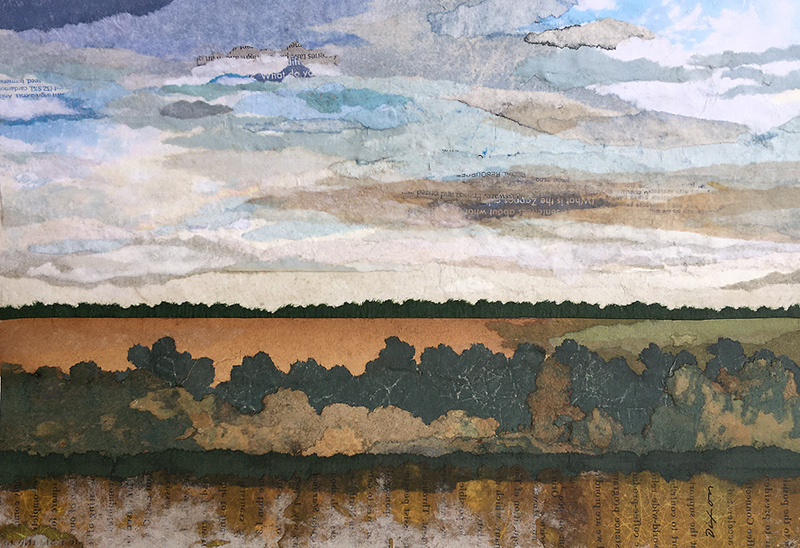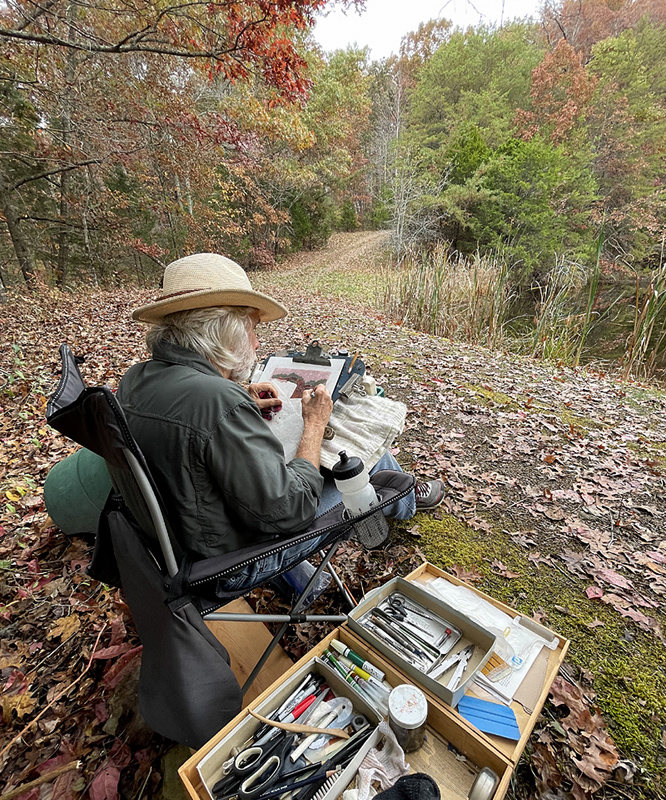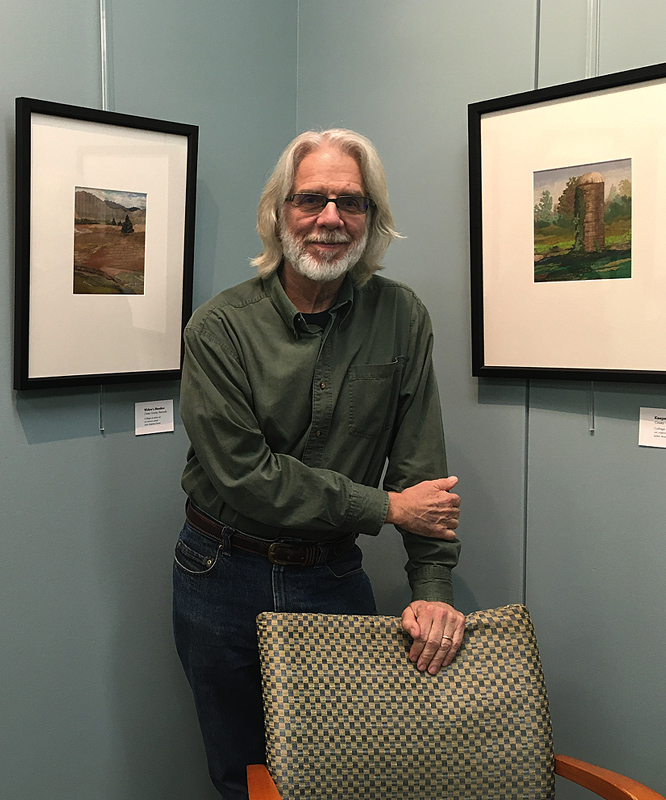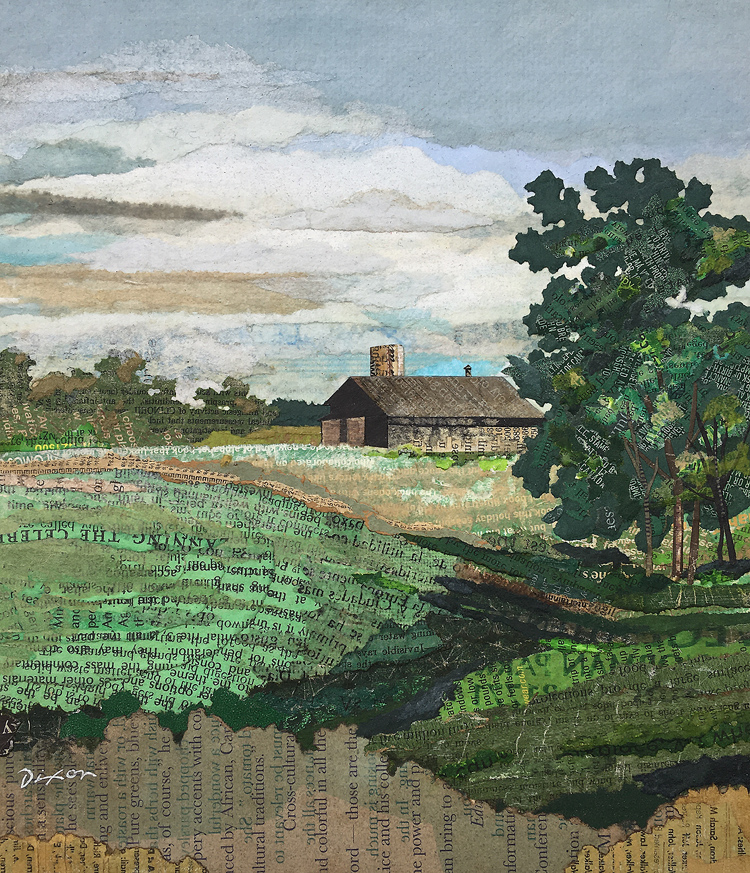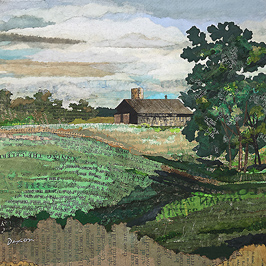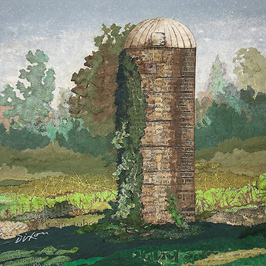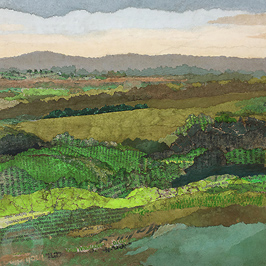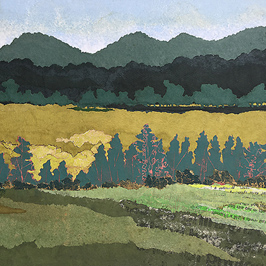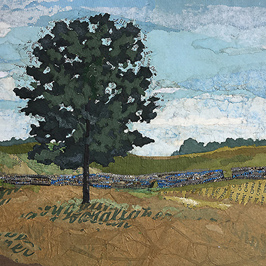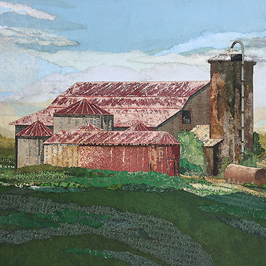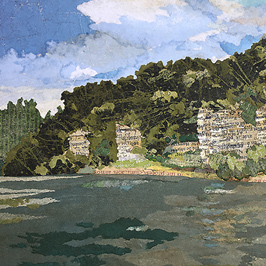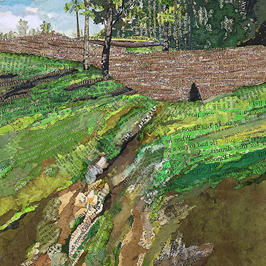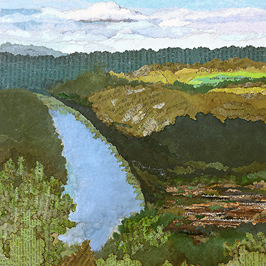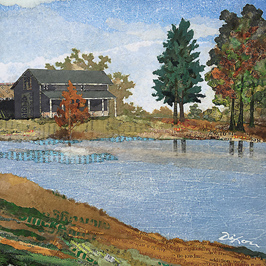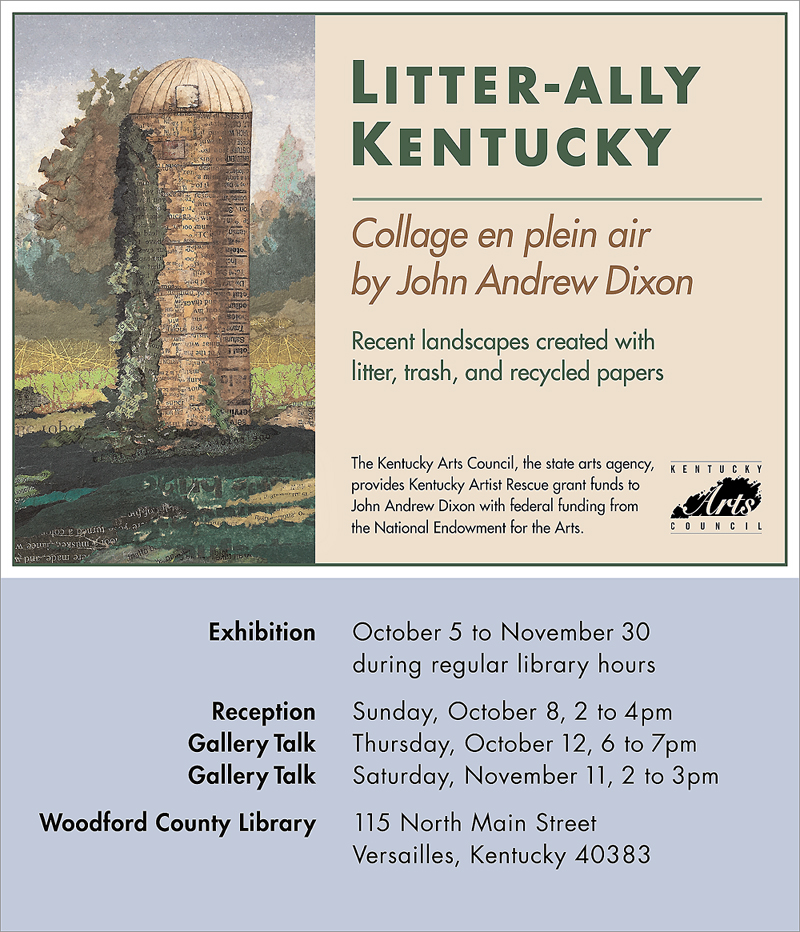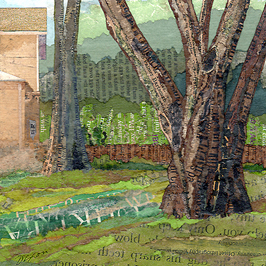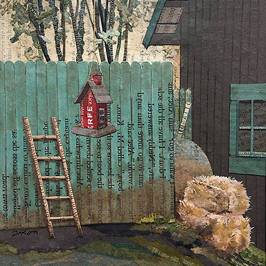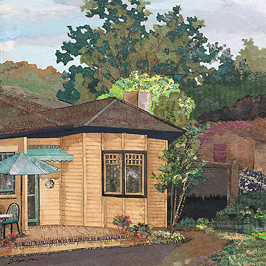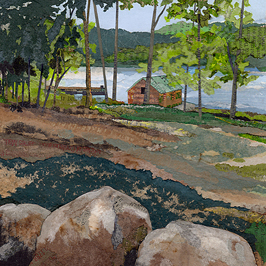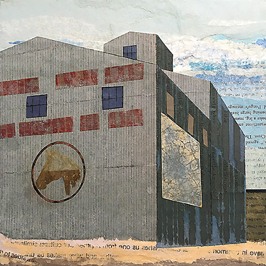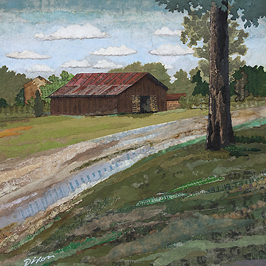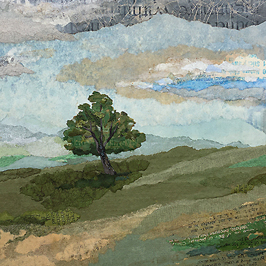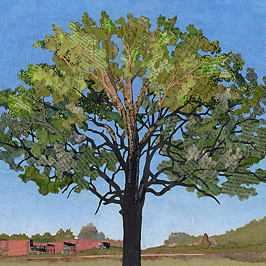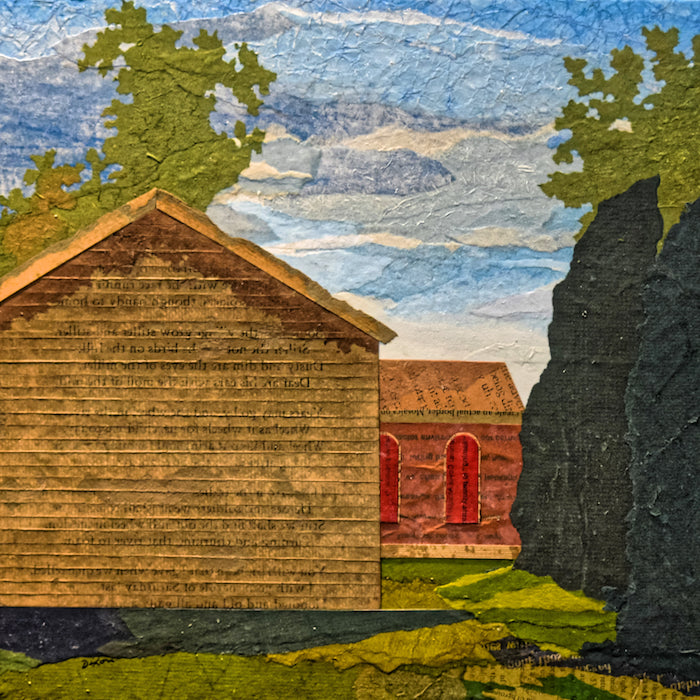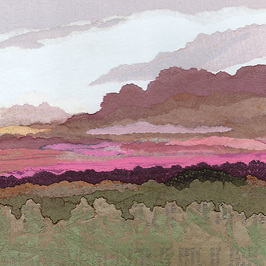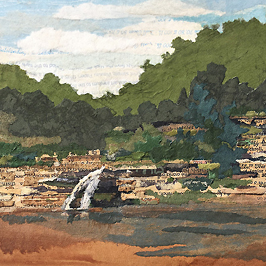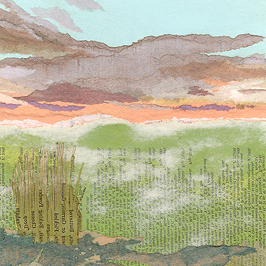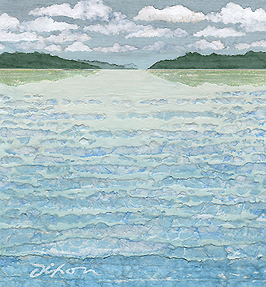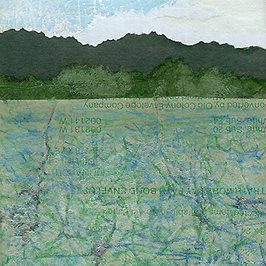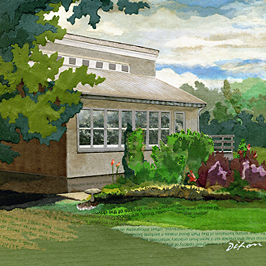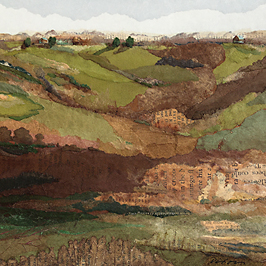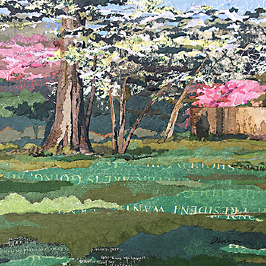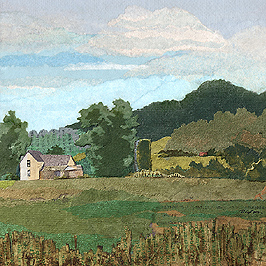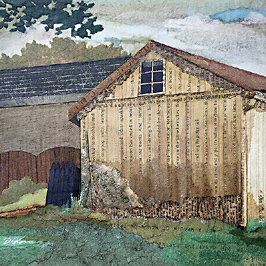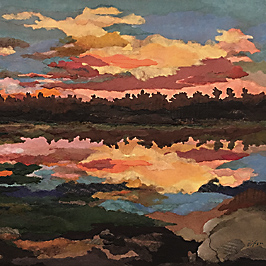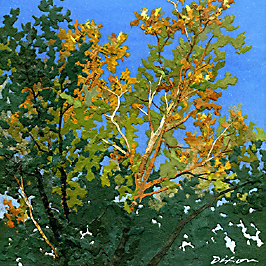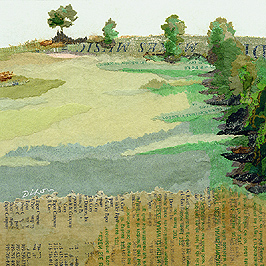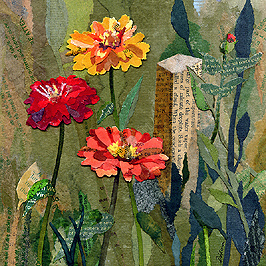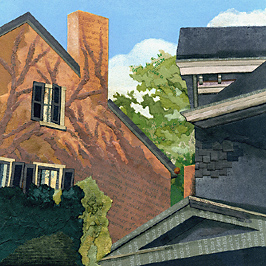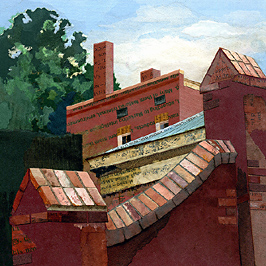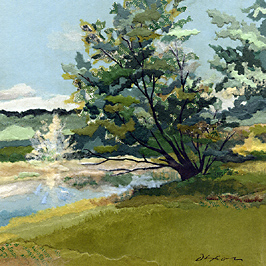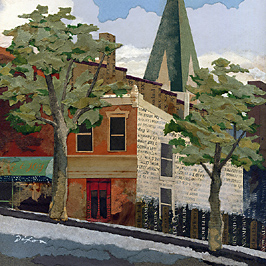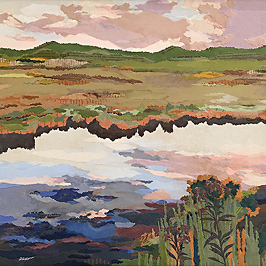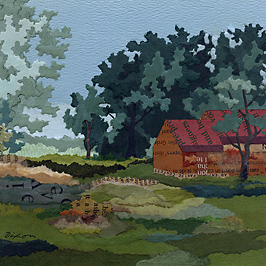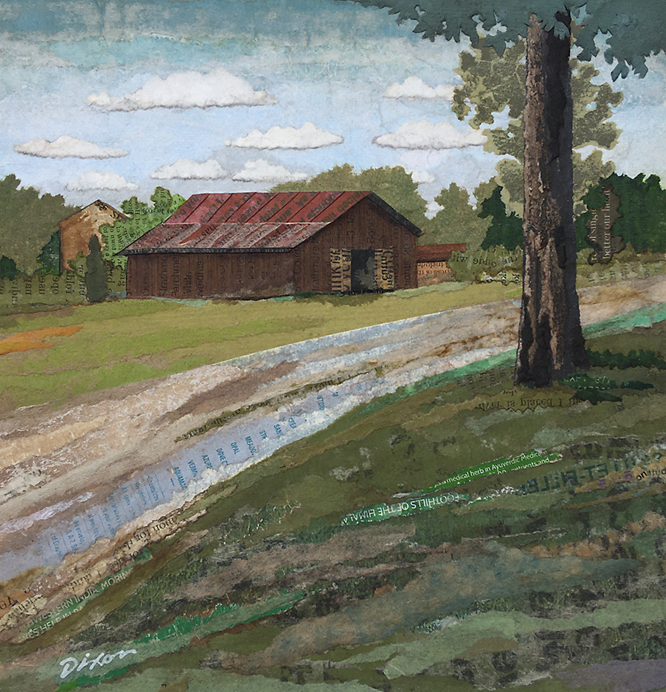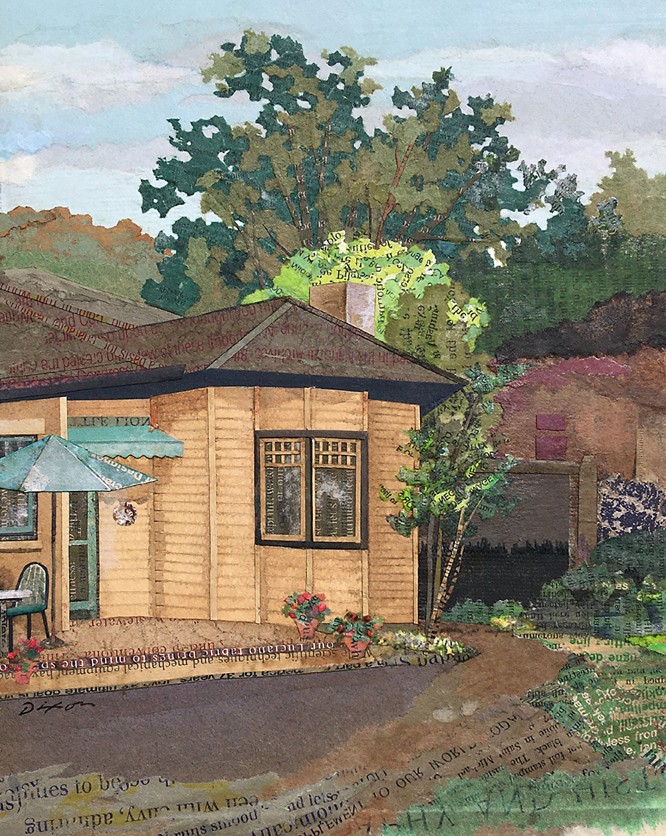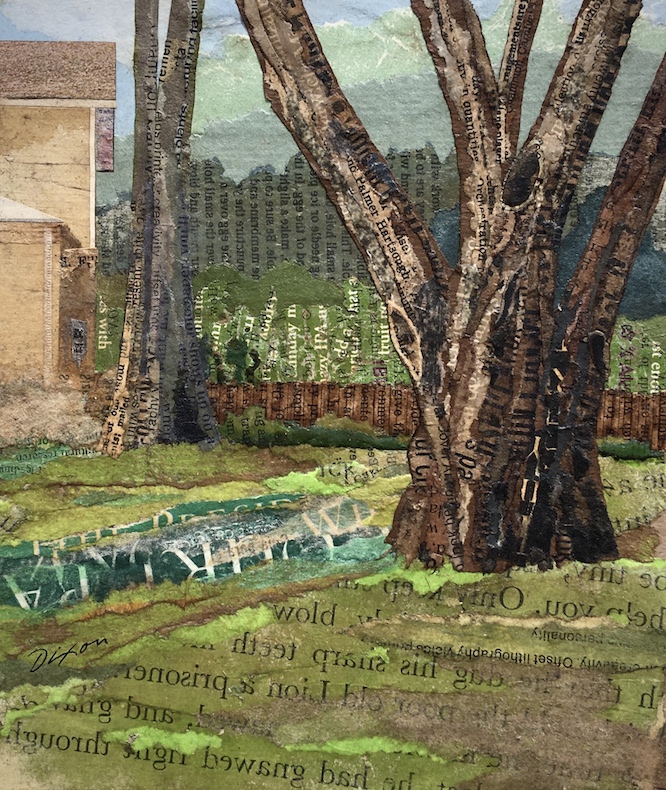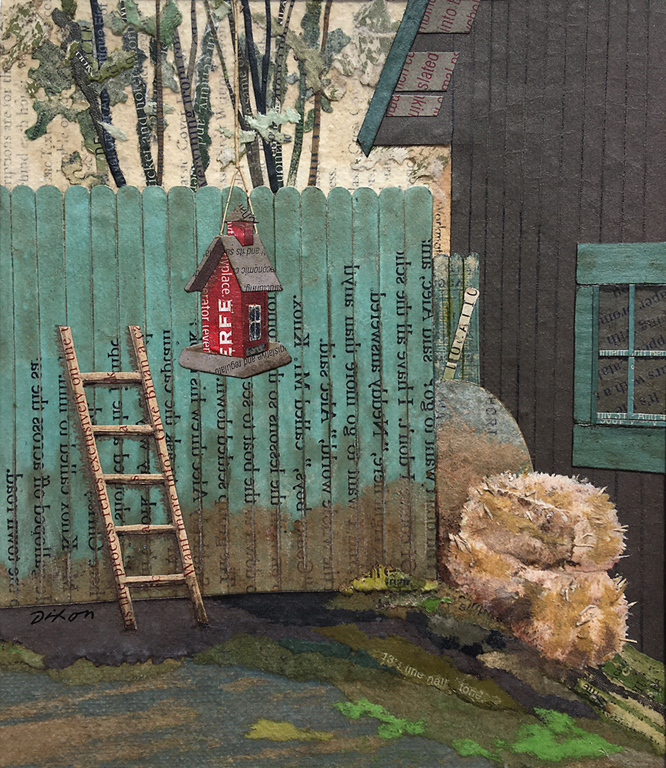My solo show of collage landscapes is back on display — this time at the Eastside Branch of the Lexington Public Library. The exhibition lasts from May 1 to June 30 — Palumbo Drive at Man O War Boulevard.
Archive for the ‘En Plein Air’ Category
Capturing an Arcadian Sky
Monday, March 25th, 2024“I have learned to expect nothing of the weather
but what it gives us.”
— Rockwell Kent
Last September at nearby Arcadia Farm, I fell under the spell of a horizon and stuck with the mood of early-morning clouds for the rest of the session. With the prevailing heat, other members of the PAACK may have been praying for more breeze, but I was grateful for hours of no wind. I wasn’t even using clothespins! I wanted to interpret the viewscape as that huge land grant might’ve looked to the original Shelby family in the 1700s. Although pleased with the result that I took home, I knew I wanted to make studio additions at the base of the artwork before declaring it ready for a signature. And so here we are, March of 2024. As I look ahead to a new season of taking collage outside, it made sense to finally complete the studio refinements on one of my favorite landscapes from 2023.
Arcadian Sky
collage en plein air by J A Dixon
11.375 x 7.875 inches
available to collectors
Believing is seeing . . .
Tuesday, November 21st, 2023“Accepting the familiar is the enemy of seeing… Seeing takes work and patience and concentration and focus otherwise we are always walking around in a fog only seeing what we think we know but not actually seeing anything at all.”
— Cecil Touchon
Although I have worked outside at entirely wild places (river palisades, for example), I seem to be drawn more to locations that have been cared for by others. To truly observe a rural setting and interpret it with found paper as a collage landscape, I need to spend hours slowing down my busy mind. I approach a kind of reverence for it as a place of evident stewardship and quiet beauty. It’s a slow-motion form of rapt attention, and I am able to see it as a fusion of natural creation with human affection. LITTER-ALLY KENTUCKY is the result.
Her Brother’s Barn
Boyle County, Kentucky
collage en plein air by J A Dixon
8 x 9.3125 inches
16 x 20 inches, framed
giclée print available
the LITTER-ally KENTUCKY collection
Monday, October 16th, 2023Thank you for your interest in this collection of plein air landscapes. The original collage artwork is infused with litter to encourage stewardship of natural places. Premium giclée prints are available here.
My solo landscape show: “LITTER-ALLY KENTUCKY”
Sunday, September 24th, 2023“At some point, the virtuosic construction of these works seems to fade in the mind, leaving in its wake only the images themselves: soft, somber, complicated skies worthy of Turner or Constable; rolling fields that would have attracted Thomas Hart Benton or Grant Wood.”
— Kevin Nance
A year after an update here about progress on my grant-supported body of new collage landscapes, I’m pleased to announce that this en plein air artwork will be revealed next month.
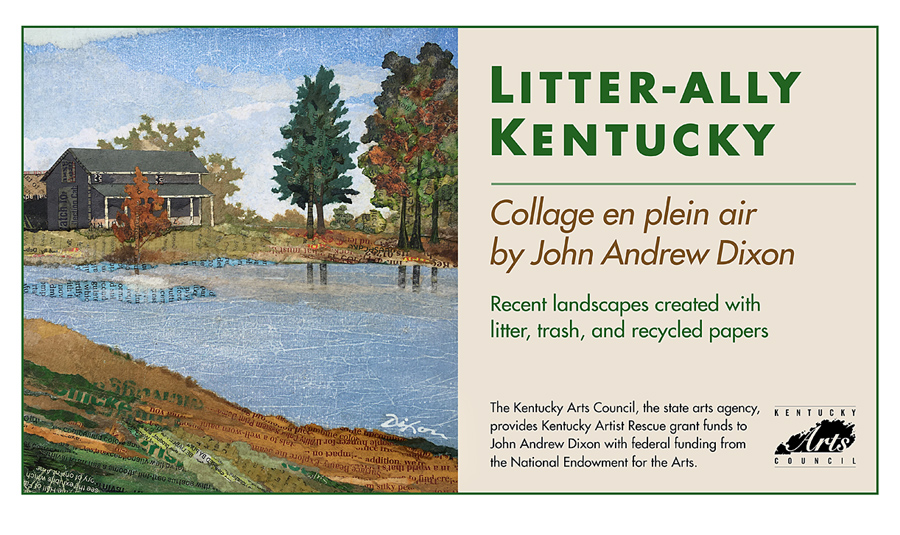
The exhibition will open on October 5 at the Woodford County Library in downtown Versailles, Kentucky, and continue through November during regular hours. The library will host an opening reception on Sunday, October 8, from 2pm until 4pm. I’ll give a gallery talk Thursday, October 12, at 6pm, and again on Saturday, November 11, at 2pm.
I’ve devoted much creative time and energy to this project over many months. Public funds have provided support and enabled me to bring a higher level of presentation to the most in-depth investigation that I’ve made into representational collage, 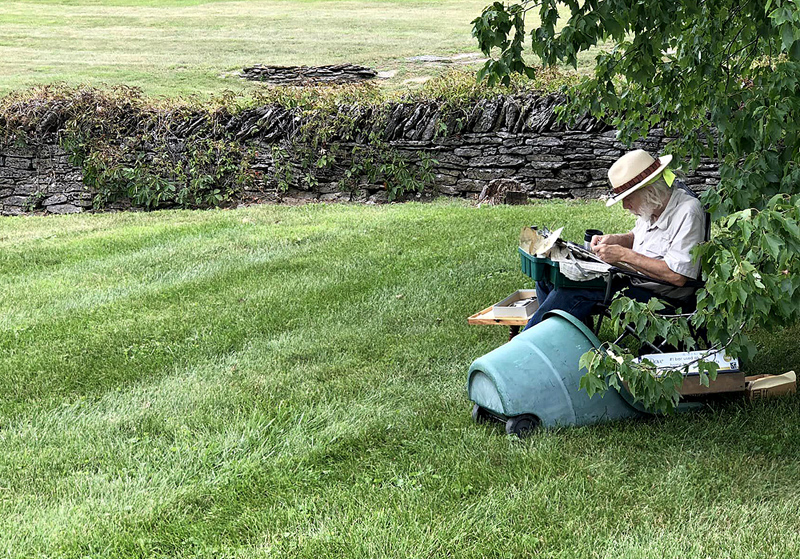 but the endeavor could not have been possible without the hospitality of those who opened their rural places to my grateful scrutiny. Fortunately, only one person declined to grant permission for me to “paint in papers.” Everyone else was astonishingly trusting and helpful. Of course, they know who they are, and I can’t thank them enough.
but the endeavor could not have been possible without the hospitality of those who opened their rural places to my grateful scrutiny. Fortunately, only one person declined to grant permission for me to “paint in papers.” Everyone else was astonishingly trusting and helpful. Of course, they know who they are, and I can’t thank them enough.
The artworks that I created at locations in six Central Kentucky counties are infused with fragments of litter accumulated along local streets and roadways. The concept of using collage art to bring awareness to the ongoing problem of littering was the theme of my application for support during the aftermath of lockdowns. I received a Kentucky Artist Rescue grant from the Kentucky Arts Council with federal funding from the National Endowment for the Arts.
Since I intend to have this show travel around a bit over the coming months, I want to acknowledge the individuals in Woodford County who offered my first opportunity: Karen Kasacavage and Tommy Dennison.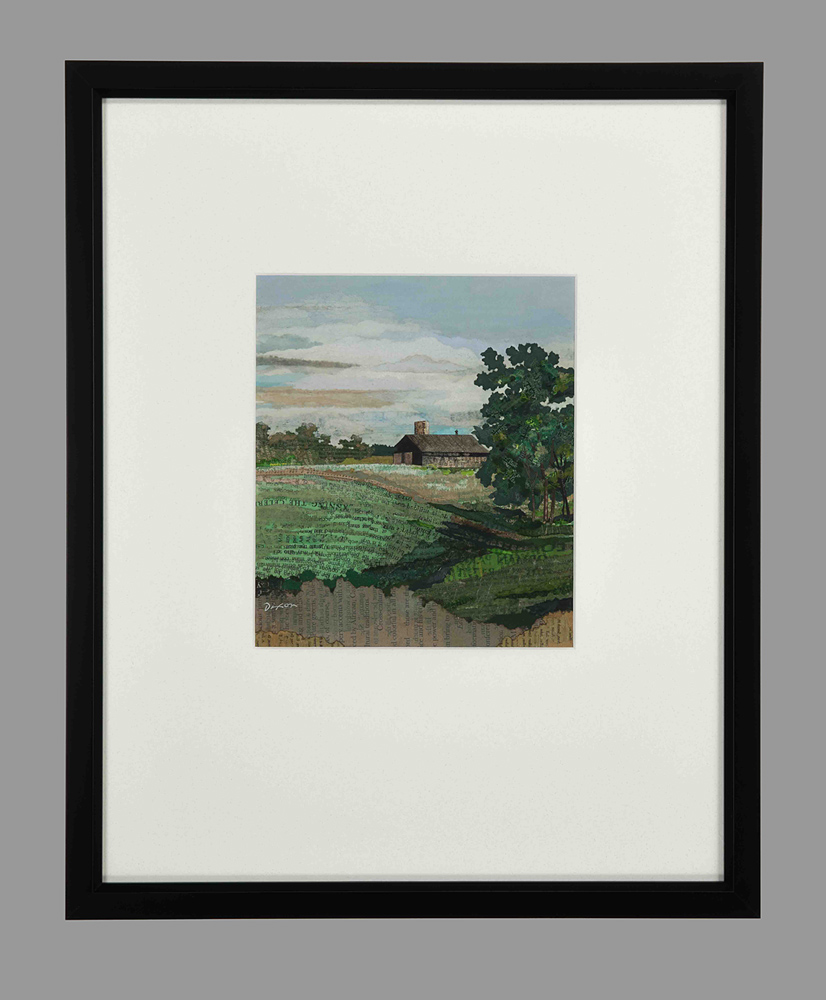 Leave it to a pair of helpful librarians to get me out of the starting gate! Because part of my overall effort is to engage both children and adults during the show’s run, this will be an ideal setting to carry an unconventional message about achieving a cleaner environment in the Commonwealth. With this recent body of work, I’ve repurposed the products of our “toss-it” culture as interpretations of specific natural places. My hope is to bring awareness to the role of individuals in reducing consumer waste and to promote a more conscious stewardship of the land that surrounds us.
Leave it to a pair of helpful librarians to get me out of the starting gate! Because part of my overall effort is to engage both children and adults during the show’s run, this will be an ideal setting to carry an unconventional message about achieving a cleaner environment in the Commonwealth. With this recent body of work, I’ve repurposed the products of our “toss-it” culture as interpretations of specific natural places. My hope is to bring awareness to the role of individuals in reducing consumer waste and to promote a more conscious stewardship of the land that surrounds us.
Each of the 16 artworks (ten verticals and six horizontals) is matted and framed in the “gallery style” within a 16×20-inch proportion. In order to allow a series of showings in different counties, the originals will not be available for purchase at this time. Instead, collector-quality glicée prints of all the landscapes on display will be offered through Fine Art Editions of Georgetown, Kentucky. You are invited to visit the exhibition and attend associated events. I also will have original collage artwork for sale across the street from the library at Art Space Versailles.
As LITTER-ALLY makes its journey around Kentucky, stop back here for more information, new developments, and to dig a bit deeper into my adventure creating collage landscapes en plein air.
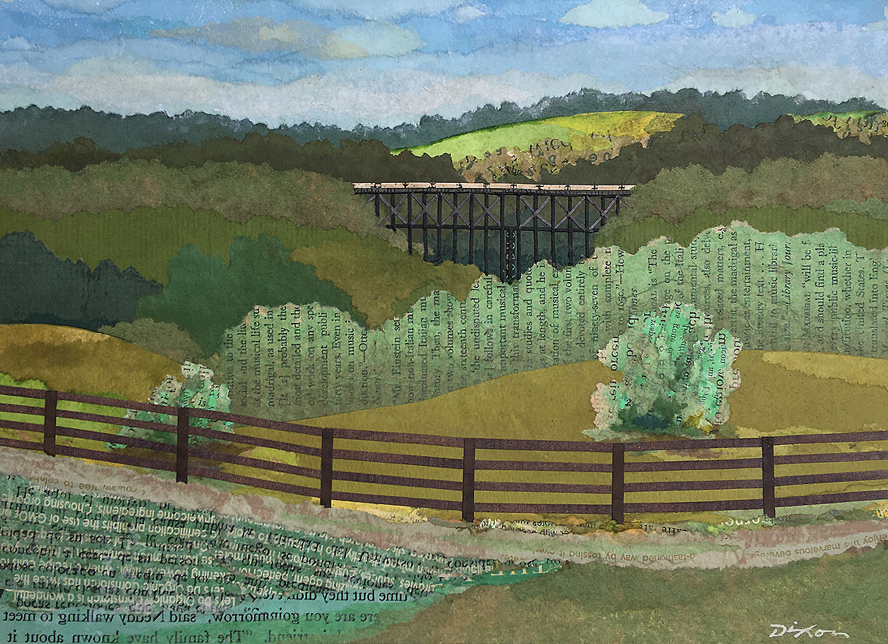
High Bridge Vantage
Garrard County, Kentucky
collage en plein air by J A Dixon
10.9375 x 7.9375 inches
20 x 16 inches, framed
giclée print available
First Gallery of Collage Landscapes
Wednesday, March 8th, 2023Thanks for your interest in my collage landscapes. Click on each thumbnail to view a larger image. Click here to scroll the original blog posts. My previously sold CHANGE OF SEEN artworks can be ordered as prints.
View the LITTER-ally KENTUCKY collection, too!
‘Outside/Inside’ is where it’s at!
Monday, January 30th, 2023“If I could say it in words there would be no reason to paint.”
– Edward Hopper
“Painting in papers” is my passion as I work in the studio to finish a season of outside starts while dreaming of springtime. There are many varieties of collage rooted in the history of art and craft. I do get lost in this particular one!

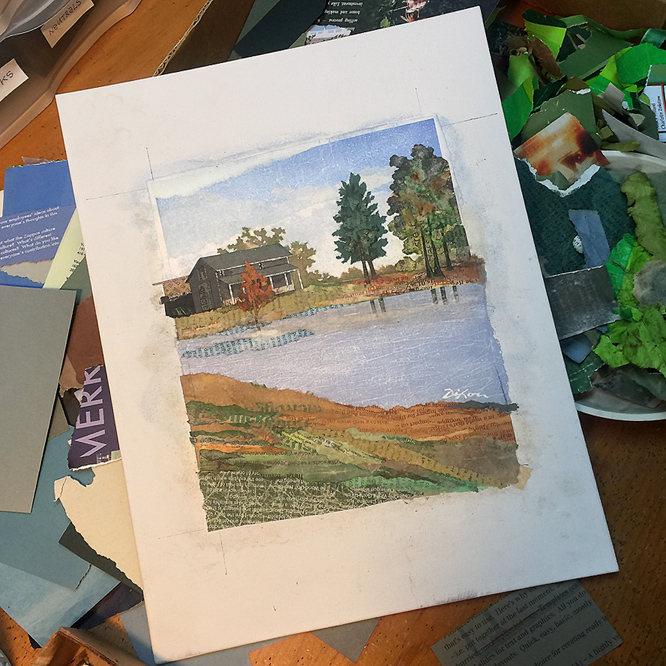
“LITTER-ally KENTUCKY” takes shape . . .
Friday, September 30th, 2022“The thing is to be attentively present. To sit and wait is as important as to move. Patience is as valuable as industry. What is to be known is always there. When it reveals itself to you, or when you come upon it, it is by chance. The only condition is your being there and being watchful.”
— Wendell Berry
At the close of 2021, based on my plein-air practice to date, I applied to the Kentucky Arts Council and received a KAR grant with funding from the National Endowment for the Arts. The goal of my project is an exhibition-worthy body of collage landscapes created from salvaged ingredients consisting of litter, trash, and recycled papers. The new works are en plein air interpretations of actual rural spots in Central Kentucky. The collection will be made available to partnering venues as a thematic exhibition that carries a call for greater awareness of how we interact with our environment. The traveling display will invite community engagement in the form of gallery talks, student opportunities, and online references — with a message for greater litter awareness and a cleaner countryside in the Commonwealth.
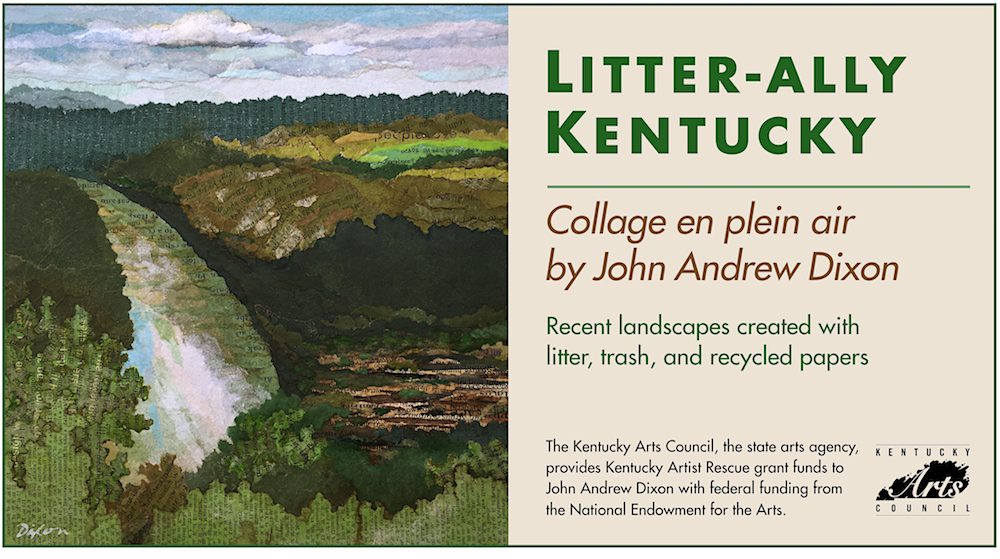
To fulfill this grant-supported process, I am nearing the end of my creation phase. It’s been a period of acquiring paper litter, arranging visits to rural locations, engaging with property owners who accommodate my on-site sessions, starting the landscapes outside, and making follow-up studio refinements. Collage artworks will have been made at over a dozen locations in six contiguous Central Kentucky counties around Danville. I avoid exceeding my outside time when completing a landscape indoors, to stay within a 50:50 ratio. 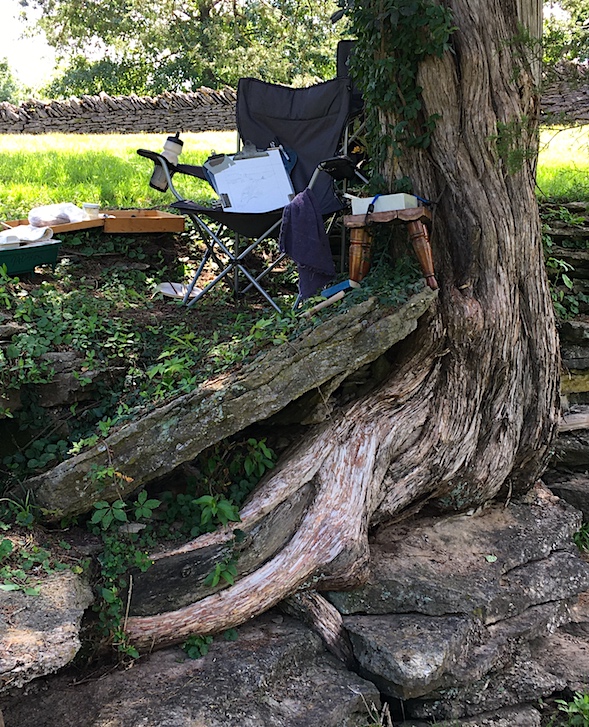 There are techniques for details that are best left to the end, when the breeze is not a factor, but my goal is to retain the fresh, intuitive quality of the initial impression.
There are techniques for details that are best left to the end, when the breeze is not a factor, but my goal is to retain the fresh, intuitive quality of the initial impression.
It often seems like I’m behind schedule, until I remind myself that the entire process is not unlike the act of being present in nature. The way forward can be revealed as much by receptivity as by forced progression. I’ll spend the balance of the year with finishing touches, having the artwork professionally framed, preparing support materials and promotions for my sought-after series of shows, plus contacting venues suitable for the traveling display (which will be chosen in part based on the anticipated reach and exposure for optimum audiences, including youngsters).
An important part of this project has been my desire to interact with the public about a relatively recent area of concentration for me as an artist — representational collage. Until they observe more closely, many people think my landscapes are traditional paintings. It’s been rewarding to watch this sense of discovery, so similar to what I experience as I explore the potential of art made from paper. This connection with others fired my enthusiasm and prompted me to propose a way to engage audiences with another layer of meaning. By including a higher percentage of litter and trash, I hope to further a conversation about the ongoing problem of litter in Kentucky and the solid waste crisis in general. As I exhibit “painted” rural scenes that were created with by-products of our wasteful society, I’m optimistic that my art will promote a more conscious regard for stewardship of natural places.
Near Catnip Hill
collage en plein air by J A Dixon
50% / 50% — site to studio
8.375 x 8.625 inches, 2022
giclée print available
Her Back Door
Wednesday, September 14th, 2022“Don’t come a-knockin’ around my door
Don’t wanna see your shadow no more
Coloured lights can hypnotize
Sparkle someone else’s eyes.”
— B L Cummings
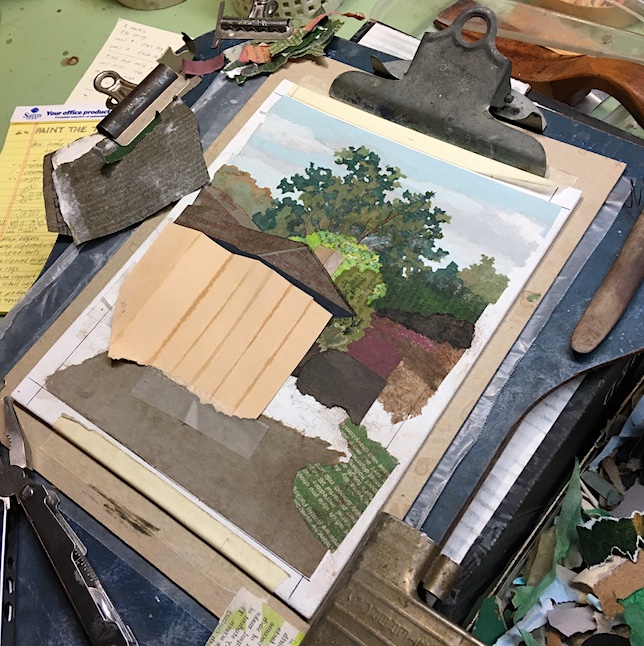 Here’s a recent plein air collage of mine that’s on display in the conference center exhibition presented by the Arts Commission of Danville / Boyle County at Constitution Square. I consider this in the category of “miniature house portraits,” which would pose challenges in any medium. Working with paper (particularly when outside) makes for a tricky process of interpreting proper perspective. It’s been suggested that I didn’t nail the vanishing points with this one, even though I completed most of the architectural treatments in the studio.
Here’s a recent plein air collage of mine that’s on display in the conference center exhibition presented by the Arts Commission of Danville / Boyle County at Constitution Square. I consider this in the category of “miniature house portraits,” which would pose challenges in any medium. Working with paper (particularly when outside) makes for a tricky process of interpreting proper perspective. It’s been suggested that I didn’t nail the vanishing points with this one, even though I completed most of the architectural treatments in the studio.
Harlan Hubbard thought that, “a painting, to be good, must be done with dash and abandonment, even one which has meticulous detail. If one niggles over it, the result is dull and lifeless.” It’s a danger for any artist to “niggle” or “noodle” at the expense of the overall expression. I haven’t convinced myself that it didn’t happen with this one, even though a plein air painter that I admire thinks otherwise. It has something to do with my intentionally introducing a contrast of crisp detail and soft ambiguity — with a debatable degree of success. I guess that the “eye of the beholder” has to take it from here. Without a doubt, I haven’t confronted this difficulty for the last time.
Her Back Door
collage en plein air by J A Dixon
7.125 x 9 inches
50:50 site/studio
available for purchase
Our “En Plein Air” show in Danville
Monday, August 22nd, 2022“And yet, standing at his appointed place, the trunk of the tree, he does nothing other than gather and pass on what comes to him from the depths. He neither serves nor rules — he transmits. His position is humble. And the beauty at the crown is not his own. He is merely a channel.”
— Paul Klee
Another anticipated En Plein Air annual exhibition has appeared and vanished, my sixth consecutive participation since I took up the challenge of “painting in papers” with the PAACK. My sincere thanks to Art Center of the Bluegrass for continuing to support our regional group!
The two miniatures that I included in the show are featured here. Completing both of them in the studio raised some concerns that I’d be able to retain my on-site impression as I made detailed additions too delicate for outdoor work. Did I manage to do it?
East End Survivor
collage miniature by J A Dixon
6 x 7.125 inches, framed 11 x 14
available for purchase
Gardener’s Nook
collage miniature by J A Dixon
6.25 x 7.25 inches, framed 11 x 14
available for purchase
